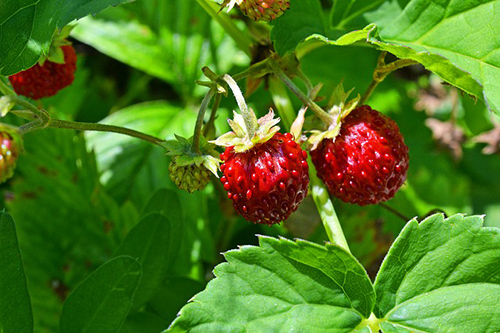Contents
When talking about the wild strawberry plant, we mean those blood-red tears that grow on bush slopes, giving an exquisite aroma, never those huge, “potato-sized” fruits with little flavor and less aroma that are sold in the market to fulfill the customer’s appetite for big things and that have been artificially cultivated with chemical pesticides and herbicides.
Strawberries have been used as a food for thousands of years. However, their medicinal properties were not discovered until the 16th century. The great Swedish botanist Linnaeus, who named many vegetal species, said he healed his gout after a diet regime where the wild strawberry plant was one of the main elements.

Wild Strawberry Plant Scientific Facts
- Other names: Strawberry.
- French: Fraisier des bois.
- Spanish: Fresal, frutilla.
- Environment: It is common on roadsides and field borders in forest regions all over Europe. It is widely cultivated in warm-climate areas of Europe and America, and it can also be found wild.
- Description: Vivacious plant of the Rosaceae family, growing from 5 to 20 cm high, with trifoliate leaves, paler on their undersides, and white flowers with five petals. Its actual fruits are the grains that stick to the strawberry surface.
- Parts of the plant used medicinally: The strawberry (false fruit) and the leaves.
Healing Properties and Uses

Strawberries contain sugars, mineral salts, vitamins A, B, and C, organic acids, coloring substances, enzymes, and mucilage. Similar to aspirin, small amounts of salicylic acid and salicylates give strawberries anti-inflammatory properties, which have also been discovered in these fruits. According to Font Quer, the juice of the wild strawberry plant is one of the most complex products of the plant kingdom due to the variety of substances it contains.
STRAWBERRIES offer health for everyone since they invigorate and stimulate organic functions and cleanse the blood. Their properties are as follows:
- Strawberries are depurative and alkalizing. They promote the elimination of waste substances such as uric acid, which causes inflammation of joints and kidneys. They are recommended for arthritis and gout caused by an excess of uric acid.
- Laxative. The wild strawberry plant’s mucilage content promotes intestinal transit and evacuation, so it is recommended to fight constipation.
- Invigorating and remineralizer. Strawberries are especially recommended for anemia, lack of appetite, and recovery from fever or weakening diseases. They increase appetite and stimulate metabolic functions.
- Emollient. When externally applied to the skin as poultices, strawberries have soothing, cleaning, and cosmetic action relatively superior to many chemical products. Even better results are achieved when using strawberry milk. They have also been used in local applications to heal chilblains, rubbing the affected parts (usually hands) with ripe strawberries daily.

Wild strawberry plants LEAVES contain tannin and flavonoids, giving them astringent and anti-inflammatory properties. They are used in the following cases:
- Diarrhea and gastro-enterocolitis due to their content in tannin.
- Skin and nipple stretch marks in local applications on the affected area, which will dry and heal.
- Inflammation of the mouth (stomatitis), of the gums (gingivitis), and the throat (pharyngitis), applied in rinsings and gargles.
How to use Wild Strawberry

- Strawberry treatment. The most effective way to use strawberries is to consume one or a half kilograms of ripe fruit daily for three or four days without other food or water.
- Infusion with 40-50 grams of leaves per liter of water. It has a pleasant flavor. Drink four or five cups daily.
- Compresses: Soak cotton compresses in the same infusion used internally but slightly more concentrated, then apply them to the skin or nipple stretch marks.
- Mouth rinses and gargles with this concentrated infusion.
- Poultices of strawberries.
- Strawberry milk.
WARNING! Strawberries may provoke an allergic reaction in sensitive people, causing itching. They can try desensitizing themselves by putting a piece of strawberry under their tongue every day for eight or ten days.
Strawberries and Beauty
To cleanse, soothe, and beautify the face’s skin, mash 300-400 grams of ripe strawberries and apply them as a poultice. Strawberry milk is made by mixing 50/50 strawberry juice and milk. This milk is used as a lotion.
DISCLAIMER: All content on this website is presented solely for educational and informational objectives. Do not rely on the information provided as a replacement for advice, diagnosis, or treatment from a qualified medical expert. If you are pregnant, nursing, or have any preexisting medical concerns, talk to your doctor before using any herbal or natural medicines.
REFERENCES
- George D. Pamplona-Roger, M.D. “Encyclopedia of Medicinal Plants.” George D. Pamplona-Roger, M.D. Encyclopedia of Medicinal Plants. Ed. Francesc X. Gelabert. vols. 2 San Fernando de Henares: Editorial Safeliz, 2000. 575, 576. Print.[Wild strawberry plant]
- https://risegardens.com/blogs/communitygarden/health-benefits-of-wild-strawberries
